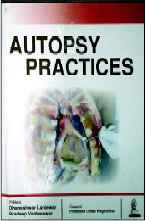Translate this page into:
Autopsy practices
Corresponding Author:
Sanjay A Pai
Columbia Asia Referral Hospital, Bengaluru, Karnataka
India
sanjayapai@gmail.com
| How to cite this article: Pai SA. Autopsy practices. Natl Med J India 2019;32:250 |
Autopsy practices. Dhaneshwar Lanjewar, Pradeep Vaideeswar (eds). Jaypee Brothers Medical Publishers, New Delhi, 2017. 180pp, ₹1650. ISBN: 9789386056160.

Fewer autopsies are being performed all over the world. In India, the two cities where autopsies were performed in large numbers and with considerable skill were Mumbai (during the times it was named Bombay) and Chandigarh. The decline of the autopsy will be detrimental to the practice of medicine, something which its proponents keep preaching, but to no effect.[1] Those of us who performed autopsies in the era when it was common (up to the 1990s) had used books by foreign authors (Ludwig’s handbook, among others) to learn the technique.
This book, the first from India on the subject, appropriately has contributors from medical colleges from Mumbai and Chandigarh, who are ably qualified to write on the subject. The book is well-written and should be a near-complete guide to those who hopefully, will perform autopsies in the future.
The book begins with a chapter on the history of the autopsy, including its history in India. This is followed by chapters on the external examination, utility and techniques of autopsy and the various organ systems. All the authors succeed in their aim of teaching the technique of performing a proper autopsy. Maternal autopsies deserve and get a separate subchapter. I was happy to see in this, as well as in some other chapters, references to papers written by Indian pathologists. In addition, essays on legal aspects of autopsy, embalming, design of the autopsy room, biosafety and autopsy audit contain considerable amounts of relevant information. The appendix of the book contains seven case studies of autopsies which make for educative reading.
There are minor lapses, which must be addressed in the next edition. Image 2c does not illustrate gross ascites (as stated in its legend). The term ‘occasional alcoholic’ (p. 165) needs to be modified, not least because there is no such phrase. There are some errors in dates. Galen lived from about 129/130 CE (or AD, to use the older term) and not from 131 BC to 200 BC .
The next edition should also contain weights of organs, adult as well as foetal and paediatric.
There is a chapter on paediatric autopsy, but I believe that foetal autopsy should also have been covered, given that there is a wealth of information in them. Besides, foetal autopsies are performed in some centres in India and are logistically and financially easier to perform. (They do not need specialized autopsy rooms and technicians.) I would also like to see a mention of the latest in autopsy research, specifically, ‘warm/ rapid autopsies’, which are performed within a few hours of death, so as to collect fresh tissue that can be used for RNA studies/genetic sequencing, etc. This is usually not possible in the standard autopsy, which is done a considerable amount of time after a person has died.
A chapter on microscopy, including a protocol on what sections should be submitted for histology, would also benefit the learner. Also, a grossing protocol or a model autopsy report would greatly enhance the utility of the book. Finally, an essay on specific contributions made by the autopsy—including by Indian autopsy pathologists—would help put the importance of the autopsy in perspective.
| 1. | Pai SA, Pandya SK. 'Living in the clouds of a vain illusion': The decline and fall of clinical autopsies. Natl Med J India 2016;29:125– 8. Natl Med J India 2016;29:125– 8.'>[Google Scholar] |
Fulltext Views
2,426
PDF downloads
1,541




